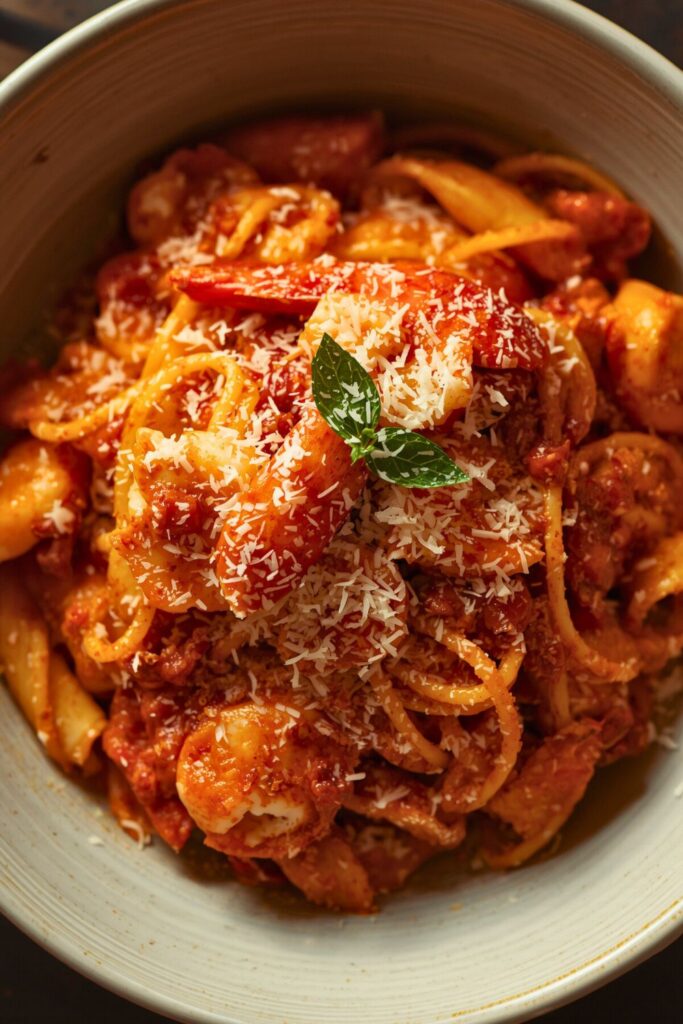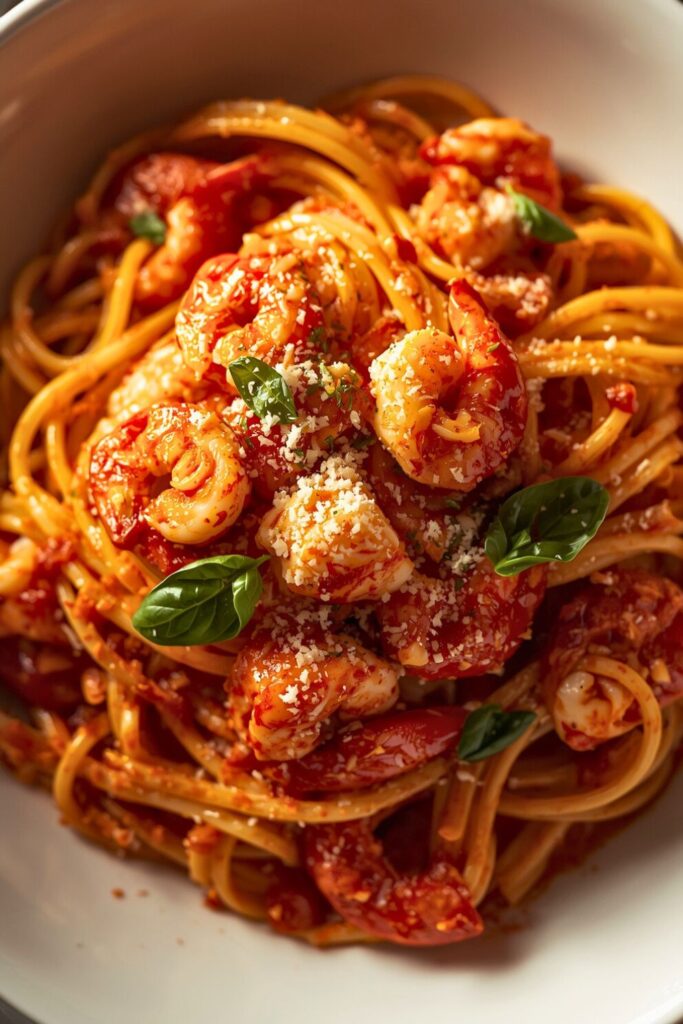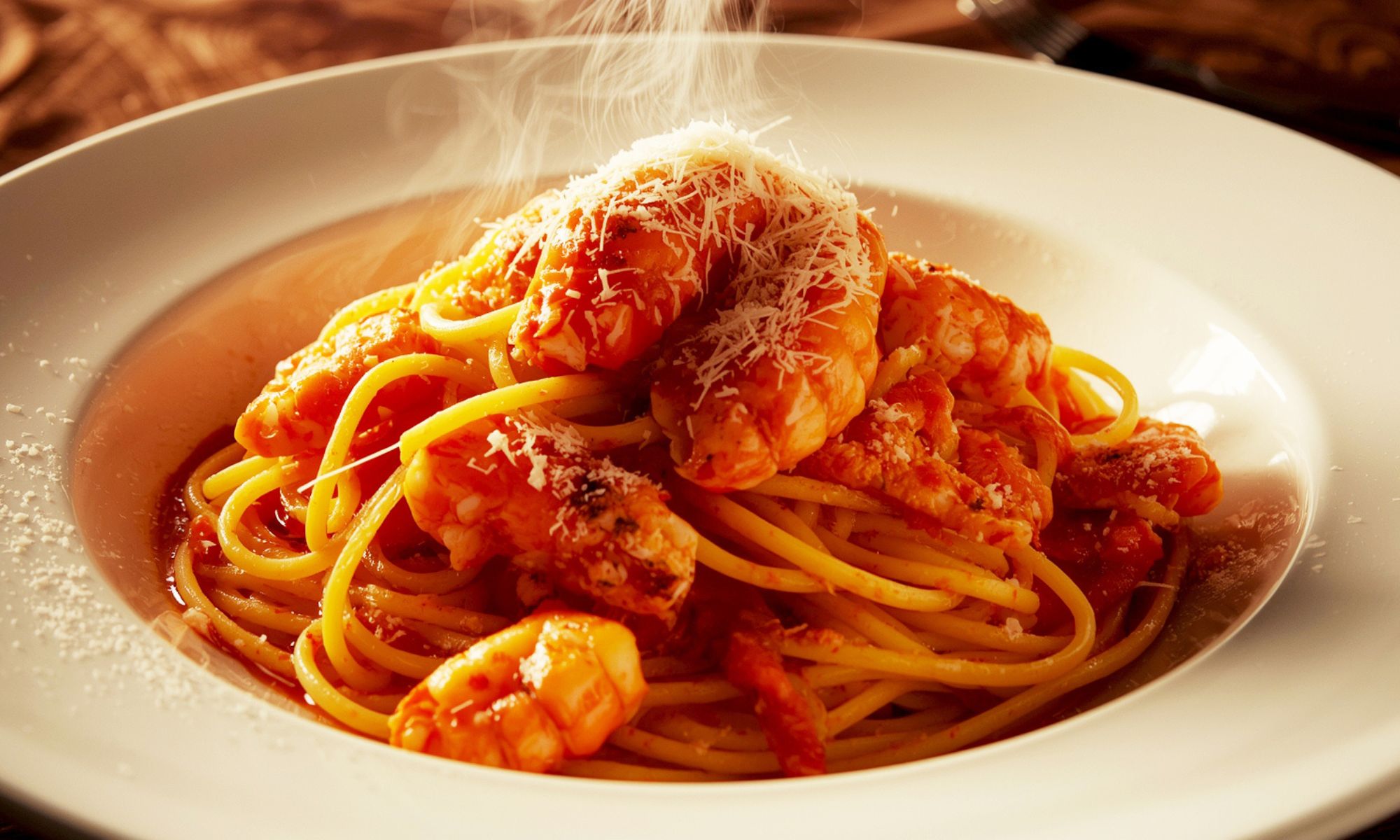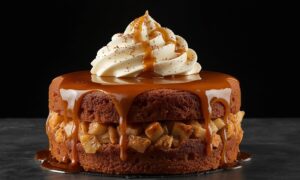The playlist is still thumping from the living room, your phone’s buzzing with group chats you’re ignoring, and the fridge is giving serious “nothing to see here” vibes. But hunger doesn’t negotiate, it demands flavor, comfort, and a little drama. That’s exactly how Creamy Spicy Lobster Pasta showed up in my kitchen: not from a perfect plan, but from a craving too stubborn to settle for leftovers.
One look at those lobster tails hiding in the freezer, and I knew it was game on. Not a cookbook fix, just me, garlic hitting butter like fireworks, chili flakes sizzling in the pan, and cream swirling into velvet. By the time the pasta hit the sauce, the kitchen smelled like pure indulgence. Sweet lobster folded in, silky richness wrapped in heat, and suddenly desperation had turned into a dish that could headline date night.
This is the recipe I want to hand you, not complicated, not staged, just bold comfort food dressed up for grownup cravings. Stick around and I’ll show you how to nail it step by step, plus give you easy variations and serving ideas. Trust me, once you taste this Creamy Spicy Lobster Pasta, it won’t just be a recipe, it’ll be your signature move.
Why This Creamy Spicy Lobster Pasta Will Ruin All Other Pasta for You

Listen, I’ve made a lot of pasta in my day. From simple aglio e olio to complex ragu that simmers for hours. But there’s something about this particular combination that just hits different.
The secret isn’t just the lobster, though using fresh, sweet lobster meat is definitely gonna elevate your life. It’s the way everything comes together. The cream sauce gets infused with all those beautiful lobster flavors when you toss the shells in there. The heat builds slowly, warming you from the inside without overwhelming that delicate seafood taste.
And here’s what really gets me excited about this recipe: it looks like something you’d pay fifty bucks for at a fancy restaurant, but once you know the tricks, it’s totally doable at home. No culinary degree required, just a little patience and some quality ingredients.
Essential Ingredients for Your Lobster Pasta Masterpiece
Let me walk you through what you’re gonna need, in the order you’ll actually use them (because who has time for alphabetical ingredient lists when you’re cooking?):
For the lobster:
- 2 whole lobsters (about 1.5 lbs each) or 1 lb cooked lobster meat
- 2 tablespoons olive oil
- Salt and black pepper
For the sauce:
- 4 tablespoons butter
- 3 cloves garlic, minced (don’t you dare use the pre minced stuff)
- 1/2 teaspoon red pepper flakes (adjust to your heat tolerance)
- 1/2 cup white wine (something you’d actually drink)
- 1 cup heavy cream
- 1/4 cup tomato paste
- 1/2 cup freshly grated Parmesan cheese
- Fresh basil leaves
- Lemon zest and juice from 1 lemon
For the pasta:
- 1 lb linguine or fettuccine (fresh if you can swing it)
- Salt for pasta water
Now, let’s talk smart swaps because not everyone lives next to a fish market, and I’m not about to leave you hanging.
Can’t find fresh lobster? Frozen lobster tails work beautifully, just thaw them properly overnight in the fridge. Or grab some high quality crab meat; you’ll get a similar sweetness and texture.
Heavy cream making you nervous? Half and half works, though your sauce won’t be quite as rich. For a lighter version, use whole milk with a tablespoon of flour to help it thicken.
No white wine? Dry vermouth is actually my secret preference, it’s got more complexity. In a pinch, even chicken broth with a splash of lemon juice will do.
Here’s the thing about picking your lobster: if you’re buying whole ones, look for active, feisty lobsters. They should feel heavy for their size. The shells should be hard and intact. And please, please don’t buy lobster that’s been sitting in a tank looking depressed for weeks.
For pasta, fresh is gorgeous if you can get it, but good dried pasta works perfectly fine. Just look for bronze cut varieties, they hold sauce better than the slick, regular stuff.
Step by Step: Creating Your Lobster Pasta Magic

Getting the lobster ready:
Start by cooking your lobsters if you bought them live. Fill a big pot with salted water, it should taste like the ocean. Bring it to a rolling boil, then plunge those lobsters in headfirst. Cook for about 8-10 minutes for 1.5 pound lobsters.
Here’s a trick that’ll save you heartache: set a timer. Overcooked lobster is like expensive rubber, and nobody’s got time for that disappointment.
Once they’re done, shock them in an ice bath to stop the cooking. When they’re cool enough to handle, crack them open and remove all the meat. Save those shells, they’re liquid gold for flavoring your sauce.
Building your sauce foundation:
Get your pasta water going first. Salt it generously, this is your only chance to season the pasta itself.
In a large, heavy bottomed pan (cast iron or stainless steel work great), heat that olive oil over medium heat. Toss in your lobster shells and let them sizzle for about 3-4 minutes. You’re extracting all those beautiful flavors into the oil.
Remove the shells and add your butter. Once it’s melted and starting to foam, add the garlic. Here’s where patience pays off, let it cook just until fragrant, maybe 30 seconds. Go too long and you’ll get bitter garlic that’ll ruin everything.
The heat and the sweet:
Add your red pepper flakes now. They need that hot fat to bloom properly and release their heat. Give them about 20 seconds, then hit the pan with your white wine.
The sizzle you hear? That’s the sound of flavor being born. Let that wine cook down by about half, you want the alcohol to cook off but keep all that bright acidity.
Now comes the tomato paste. This might seem weird, but trust me on this one. It adds this subtle sweetness and depth that makes people go “what IS that?” in the best way possible. Cook it for about a minute until it darkens slightly.
Bringing it all together:
Pour in your cream slowly, stirring constantly. The sauce should come together into something silky and gorgeous. Let it simmer gently while your pasta finishes cooking.
Drop your pasta into that boiling water now. Cook it just until it’s al dente, it’s gonna finish cooking in the sauce, so you want it slightly underdone.
Add your lobster meat to the sauce in the last minute. Just long enough to heat through, remember, it’s already cooked.
The finale:
Reserve a cup of pasta water before you drain, this starchy liquid is your secret weapon for perfect sauce consistency. Drain the pasta and immediately add it to your sauce pan.
Toss everything together, adding pasta water a little at a time until the sauce coats every strand perfectly. Remove from heat and add your Parmesan, fresh basil, lemon zest, and a squeeze of lemon juice.
The Science Behind Your Silky Sauce Success
Ever wonder why some cream sauces are pure perfection and others turn into a separated mess that looks like it belongs in a science experiment gone wrong?
It all comes down to temperature control and emulsification. When you add cream to a hot pan, you’re creating an emulsion, basically convincing fat and water to play nice together. Keep the heat moderate, and those molecules stay happy. Crank it up too high, and you’ll end up with broken, grainy sauce.
That pasta water I mentioned? It’s loaded with starch from the pasta, which acts like a natural thickener and helps everything bind together beautifully. Professional chefs call it “pasta gold” for a reason.
The tomato paste adds more than just flavor, it’s got natural sugars that help balance the acidity of the wine and the richness of the cream. Plus, it gives the sauce this gorgeous peachy color that makes the lobster pop visually.
Here’s something cool about lobster: it’s naturally sweet because of its glycogen content, which is why it pairs so beautifully with cream and plays so well with heat. The red pepper flakes don’t compete, they enhance that sweetness by creating contrast.
The key tool here is a heavy bottomed pan. It distributes heat evenly, preventing hot spots that can break your sauce or burn your garlic. If you’ve got a good cast iron skillet or heavy stainless steel pan, you’re golden.
Making It Instagram Worthy and Absolutely Delicious
Let’s talk presentation because this dish deserves to look as good as it tastes.
Warm your serving bowls, seriously, this makes such a difference. Hot food on cold plates is a crime against cuisine. Run them under warm water or stick them in a low oven for a minute.
When you plate, use tongs to twirl the pasta into little nests. Distribute the lobster pieces evenly, nobody wants to be the person who gets the bowl with just one sad piece of lobster.
Finish with a drizzle of good olive oil, some freshly cracked black pepper, and a few torn basil leaves. If you’re feeling fancy, a little lemon zest on top makes everything pop.
For wine pairing, you want something that won’t compete with the delicate lobster. A crisp Chardonnay or Pinot Grigio works beautifully. If you’re more of a red wine person, go light, maybe a Pinot Noir that won’t overpower the seafood.
Side wise, keep it simple. A light arugula salad with lemon vinaigrette cuts through all that richness perfectly. Some crusty bread for sopping up every last drop of sauce doesn’t hurt either.
Your Creamy Spicy Lobster Pasta Success Story Starts Here

This recipe is about more than just combining ingredients, it’s about creating something that makes people remember why they fell in love with food in the first place. Every time I make this Creamy Spicy Lobster Pasta, I’m reminded of that little restaurant in Maine and how one perfect dish can change everything.
The beauty of this recipe lies in its balance. Sweet lobster, rich cream, gentle heat, bright acidity, every element has a purpose, and when they come together, magic happens.
Don’t be intimidated by the lobster. Yes, it’s a bit of an investment, but think about what you’d pay for this dish at a restaurant. Plus, there’s something deeply satisfying about creating restaurant quality food in your own kitchen.
Remember, cooking is about confidence as much as it is about technique. Trust your instincts, taste as you go, and don’t be afraid to adjust seasonings. Every stove is different, every palate is unique.
Frequently Asked Questions
Can I make this ahead of time?
You can prep the lobster and make the sauce base a day ahead, but I wouldn’t recommend making the complete dish in advance. Cream sauces and pasta don’t play well together when reheated, the pasta gets mushy and the sauce can separate. Your best bet is to have everything prepped and then do the final assembly fresh.
What if my sauce breaks or looks grainy?
Don’t panic, this is totally fixable! Remove the pan from heat immediately and whisk in a tablespoon of cold butter or cream. If that doesn’t work, try adding a splash of pasta water and whisking vigorously. Sometimes starting over with a fresh pan and gradually whisking in the broken sauce works too.
How do I know when the lobster is perfectly cooked?
The meat should be opaque white with no translucent spots, and it should feel firm but not tough when you press it. If you’re cooking live lobsters, the shells will be bright red when done. Remember, you can always cook it a bit more, but you can’t undo overcooked lobster.
Can I substitute the lobster with other seafood?
Absolutely! Jumbo shrimp, scallops, or crab all work beautifully in this recipe. Shrimp cook super fast, just a couple minutes per side. Scallops should be seared until golden. Crab is already cooked, so just fold it in at the end like you would with cooked lobster meat.
Why does my pasta sauce seem too thin or too thick?
This is usually about pasta water magic! If it’s too thick, add pasta water gradually until it reaches that perfect coating consistency. Too thin? Let it simmer a bit longer, or add a bit more cheese which helps thicken naturally. The sauce should coat the back of a spoon but still move freely in the pan.

Swiftly Captions by Tina Smith — Quick, flavorful food recipes made simple, bringing fresh inspiration to your kitchen every day






